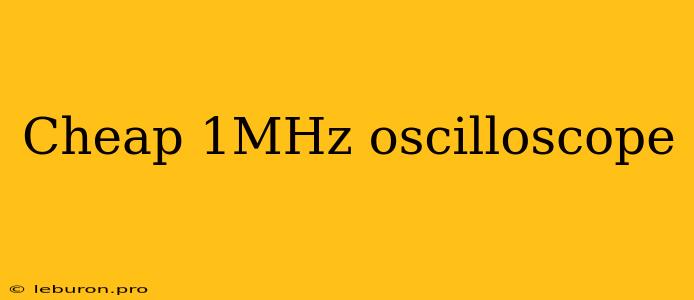Navigating the World of Budget-Friendly Oscilloscopes: A Guide to Finding the Right 1MHz Oscilloscope for Your Needs
In the world of electronics, an oscilloscope is an indispensable tool for anyone serious about understanding and debugging circuits. While high-end oscilloscopes offer unparalleled performance and features, they come with a hefty price tag that may not be feasible for hobbyists, students, or those working on budget-constrained projects. Thankfully, there are a range of cheap 1MHz oscilloscopes available on the market, providing a cost-effective way to get started with waveform analysis and circuit troubleshooting.
This guide aims to help you navigate the complexities of choosing a cheap 1MHz oscilloscope that meets your specific needs and budget. We'll discuss key factors to consider, explore popular options, and highlight essential features to look for.
Understanding the Basics: What is a 1MHz Oscilloscope?
A 1MHz oscilloscope is a device that displays the voltage of an electronic signal over time. The "1MHz" refers to its bandwidth, indicating the highest frequency signal it can accurately measure. While 1MHz may seem limited compared to the gigahertz bandwidth of professional oscilloscopes, it is more than sufficient for many applications, especially in areas like:
- Basic Electronics Education: Students learning about circuits and signal analysis often find cheap 1MHz oscilloscopes to be ideal learning tools.
- Hobbyist Projects: Whether you're building a robot, experimenting with Arduino, or tinkering with audio circuits, a 1MHz oscilloscope offers sufficient resolution for most hobbyist applications.
- Simple Circuit Troubleshooting: For basic troubleshooting tasks like identifying signal glitches, verifying signal integrity, or checking for proper timing in simple circuits, a 1MHz oscilloscope can be a valuable tool.
Key Factors to Consider When Choosing a Cheap 1MHz Oscilloscope:
When choosing a cheap 1MHz oscilloscope, it's crucial to consider factors beyond just the bandwidth. Here are some essential considerations:
1. Sampling Rate:
The sampling rate determines how often the oscilloscope captures data points of the signal. A higher sampling rate allows for more accurate representation of fast-changing signals. While a 1MHz bandwidth oscilloscope won't need a super-fast sampling rate, look for models with a sampling rate of at least 10 times the bandwidth, ideally 10-20 times, for decent accuracy.
2. Number of Channels:
A cheap 1MHz oscilloscope can have one or two channels. Two channels allow you to simultaneously observe two signals, which is helpful for analyzing the relationship between signals. However, if you primarily need to observe single signals, a one-channel oscilloscope will suffice and save you money.
3. Input Impedance:
Input impedance affects how the oscilloscope interacts with the circuit being measured. A high input impedance, typically 1 MΩ, minimizes the impact of the oscilloscope on the circuit.
4. Triggering:
Triggering functionality allows you to capture specific parts of a signal. It can be a simple edge trigger, or more advanced features like slope, pulse width, or pattern triggers. While more complex triggers are often found on higher-end models, simple edge triggering is sufficient for many basic applications.
5. Display:
The display size and resolution can significantly impact the usability of the cheap 1MHz oscilloscope. A larger, higher-resolution display provides a clearer view of the signal waveform and finer detail. Look for models with a good screen size and adequate resolution for your needs.
6. Additional Features:
Cheap 1MHz oscilloscopes may offer additional features, including:
- Measurement Functions: These can automatically measure parameters like frequency, amplitude, period, and duty cycle.
- Storage and Data Analysis: Some oscilloscopes allow you to store waveforms or export data for further analysis.
- Connectivity: Features like USB connectivity allow you to transfer data to a computer for more in-depth analysis.
Popular Options in the Cheap 1MHz Oscilloscope Market:
Here are a few well-regarded options in the cheap 1MHz oscilloscope market:
1. Digital Storage Oscilloscopes (DSOs):
DSOs offer digital storage capabilities, allowing you to capture and analyze waveforms. They often have more advanced triggering and measurement functions compared to analog scopes.
2. Analog Oscilloscopes:
While less common today, analog scopes can still be a viable option for simple applications. They are typically more affordable than DSOs but lack the digital storage and measurement capabilities.
3. Mixed-Signal Oscilloscopes:
Mixed-signal oscilloscopes combine analog and digital channels, allowing you to analyze both analog and digital signals simultaneously. These are often found on higher-end oscilloscopes but are becoming increasingly accessible in the budget category.
Recommendations for Finding the Right Cheap 1MHz Oscilloscope:
- Define Your Needs: Determine the primary applications for the cheap 1MHz oscilloscope and the level of functionality you require.
- Research Thoroughly: Read reviews from other users, compare features and specifications, and look for recommendations on forums and online communities.
- Set a Realistic Budget: Remember that you can get a good quality cheap 1MHz oscilloscope without spending a fortune. Set a budget and stick to it.
- Choose Reputable Brands: Look for reputable brands known for their quality and reliability.
Conclusion:
Investing in a cheap 1MHz oscilloscope can be a wise decision for hobbyists, students, and anyone needing a budget-friendly tool for basic electronics work. By carefully considering the factors discussed above, you can find a cheap 1MHz oscilloscope that meets your specific requirements and helps you explore the world of electronics with confidence. Remember, while price is important, choosing a well-built cheap 1MHz oscilloscope from a reputable brand ensures that it will serve you well for years to come.
